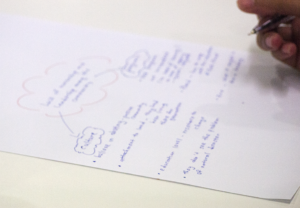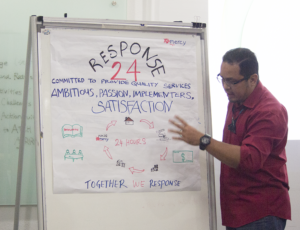A Report of Capacity Building Workshop in Malaysia

Creative thinking, or divergent thinking, is a powerful tool to transform an unsolved issue to a solvable one. Many organizations wish to make innovation to solve the long-sitting problem in the organization but find it difficult because they are caught up by issues and limit their thinking. Developing an unconventional idea requires both divergent thinking and convergent thinking, and the combination of those two different approach is vital for innovation. The case of the workshop with Mercy Malaysia shows how they have managed to take advantage of such thought process.
 Mercy Malaysia is a southern-based international NGO providing medical assistance in emergency situation across the world. Like other international NGOs, better organization management has been one of the strategic objectives of Mercy Malaysia. The workshop was convened on October 2nd and 3rd to discuss major issues facing them, and 4 teams were selected based on pre-workshop consultation; logistics, monitoring and evaluation, volunteer management, and disaster risk reduction. The teams were facing different, but all significant challenges. In case of logistic team, it was the lead time for the medicine and medical equipment to be delivered to the project operation site. Because the operation of Mercy Malaysia extends across the world, establishing the logistic system that cater to the needs of diverse location just in time has been the challenge.
Mercy Malaysia is a southern-based international NGO providing medical assistance in emergency situation across the world. Like other international NGOs, better organization management has been one of the strategic objectives of Mercy Malaysia. The workshop was convened on October 2nd and 3rd to discuss major issues facing them, and 4 teams were selected based on pre-workshop consultation; logistics, monitoring and evaluation, volunteer management, and disaster risk reduction. The teams were facing different, but all significant challenges. In case of logistic team, it was the lead time for the medicine and medical equipment to be delivered to the project operation site. Because the operation of Mercy Malaysia extends across the world, establishing the logistic system that cater to the needs of diverse location just in time has been the challenge.
 While successfully identified and analyzed the issue on day 1 of the workshop, the logistic team faced new challenge, which was that they had felt like the issue was too complex and the solution they came up with, such as providing training and disseminating code of conduct to all staff, seemed only partial to solve the issue. At this point, they were caught up with all the restriction and limitation of their own resource, not thinking much of external resource was around the issue. This is where many people get stuck – thinking in silos.
While successfully identified and analyzed the issue on day 1 of the workshop, the logistic team faced new challenge, which was that they had felt like the issue was too complex and the solution they came up with, such as providing training and disseminating code of conduct to all staff, seemed only partial to solve the issue. At this point, they were caught up with all the restriction and limitation of their own resource, not thinking much of external resource was around the issue. This is where many people get stuck – thinking in silos.

In the ‘dream session’ followed by problem analysis, all the analysis done in the previous session was set aside, and the team discussed what is the ideal logistics if all the restriction and challenges were removed. After the discussion, the team finally came up with a tag line “24H anywhere in Asia,” which represents their vision and commitment to dramatically reduce lead time in delivering their medicine and medical equipment across Asia. This concept enabled the team to have more holistic view of their service, and stimulated more creative thinking such as collaborating with a private company who has region-wide distribution channel, and sign MoUs with other ADRRN members to store the goods and share them in case of emergency. When the team went back to the issue they had analyzed, it was something solvable because now they had more resource and partners in their mind. This change in perception was the breakthrough moment.
It’s not only divergent thinking that helps your idea to develop but the combination of convergent thinking and divergent thinking is the key success factor in concept making. While convergent thinking defines the scope of the project and structures the issue by identifying causes and effects, divergent thinking helps you remove the restriction and widen your perspective. Whether it’s a workshop or team meeting, deliberately using these two methods helps your idea to make a leap forward.